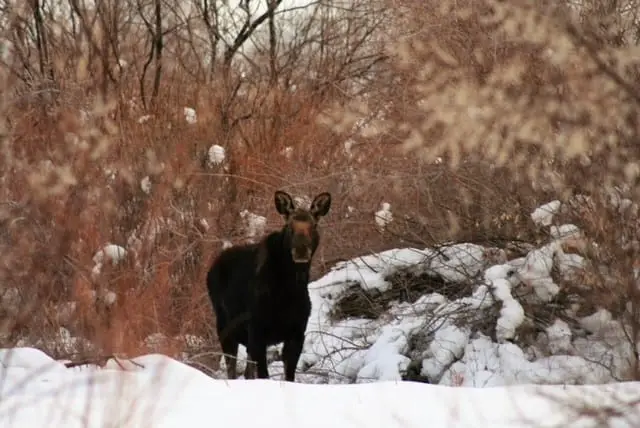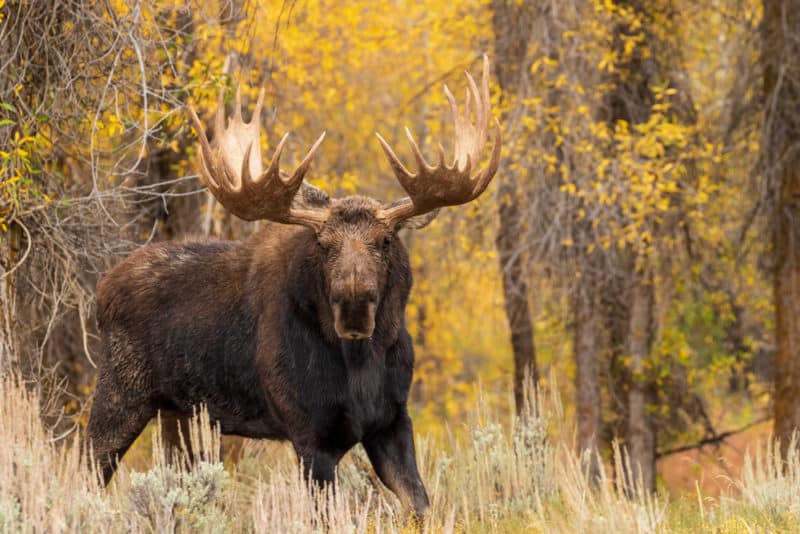Yes, there are moose in Utah. That hasn’t always been the case, though. According to the book “Utah Mammals” by Claude T Barnes, historically, the deer family’s largest member was not a Utah resident until the early 1900s. The animals migrated into the state from Idaho and Wyoming. The first moose sighted in the state was at the head of Spanish Fork Canyon in 1906 or 1907. The next reported sighting came in 1918 from the Bear River drainage on the north slope of the Uinta Mountains in northeastern Utah. The animals naturally increased, and in 1947, the UDWR determined that there was a resident moose herd on the Uinta north slope.
Utah’s Moose Population
The first aerial survey conducted in the state to specifically count moose was done on the north slope of the Uintas in 1957. This survey counted 59 moose.
During this period, moose observations in other mountainous areas of northern Utah also increased. According to this article on Wild About Utah, the population has grown and fluctuated through the years, peaking at 3,500 in 2005.
I contacted the Utah Division of Wildlife Resources office for current population numbers. Per their estimates, in 2021, there were 2,510 moose in Utah. Also, in 2020, there were 2,600, and in 2019, there were 2,570.
There are no moose in extreme southern Utah. There are, however, moose in the following south-central regions.
- Fish Lake National Forest, east of Salina
- The San Pitch Mountains east of Ephriam and Manti
- The Range Creek region of the Book Cliff Mountains southeast of Wellington
What Kind Of Moose Are In Utah?
Utah moose are of the Shiras (pronounced Shy-ras) subspecies. Shiras moose, also called Wyoming moose, is North America’s smallest moose of the four subspecies. They’re still the largest animals in Utah’s high country. Adult Shiras moose bulls still weigh up to 1200 lbs. They also stand up to 5 ft. and 9 inches at the shoulder. Also, see Moose Subspecies Of North America.
Utah Moose Habitat
Most of Utah’s moose country is concentrated in the mountains in the northern and northeastern portions of the state. According to “Wild Aware Utah,” they live in forest habitats. However, whenever possible, they prefer to be in a mixture of wooded areas and open areas that contain lakes and/or wetlands. Moose love aquatic vegetation and are excellent swimmers when they need to be. Their hairs are hollow. This makes them more buoyant and gives them extra insulation.
Moose may love the wetlands of northern Utah, but they’re also adaptable. They thrive on the oak brush-covered side hills above Salt Lake City and Park City, Utah.
Moose Hunting In Utah
The first state-sanctioned moose hunt in Utah occurred in 1958, and hunts have occurred yearly since then. Hunting licenses for Bull moose are the most highly sought-after tags in the state. Hunters have to enter a drawing for the chance to obtain one. What’s more, they’re a once-in-a-lifetime license. In other words, once you’ve successfully drawn a Utah bull moose tag, you’ll never be eligible to enter the drawing for another.
The data from 2017 showed that residents of Utah had about a 1 in 220 chance of successfully drawing out for a bull moose permit. The odds for non-Utah residents to successfully draw out were 7 1/2 times worse or 1 in 1644.
Factors Affecting Utah’s Moose Population
Predators
Mountain lions kill moose despite their large size. After humans, mountain lions prey on more Utah moose than any other animal. According to the Utah Division of Wildlife Resources, in 1995, mountain lions killed 4 out of 7, or 57% of the moose on which they had placed radio collars in the Manti unit. Additionally, in that same year, mountain lions killed 2 out of 9 radio-collared moose in the Fish Lake unit. However, the degree of predation by cougars is determined by their population density and the availability of other prey. In the time period from 2013 to 2016, on the north slope of the Uinta Mountains and in the Wasatch Mountains, 0 of the 36 mortalities of collared moose were mountain lion kills. Source
Black bears are currently the only bear species in Utah. They are effective predators of moose calves in some areas. One study suggests that black bears are responsible for the mortality of 2 to 50% of all moose calves. However, as stated above, predators choose different prey in different geographic areas. Their preferences are affected by what food sources are available. In some areas, 96% of a black bear’s diet contains plant material. A 2004 study of black bear scat in the Hobble Creek area of the Wasatch Mountains revealed no evidence of moose remains.
Are Black Bears Dangerous to Humans?
Wolves prey on moose in areas where they have established populations. However, according to the Utah Division of Wildlife Resources, there are no established wolf packs in the state of Utah at this time. Since 2015 there have been 15 to 20 confirmed wolf sightings within the state. So far, these have all been transient animals passing through from Idaho or Wyoming. Source
Grizzly bears would prey on Utah moose if they were in the state. However, they are expatriated from Utah. A famous Grizzly bear named Old Ephriam was killed in Logan Canyon in the Bear River range on August 22, 1923. Legend has it that this was Utah’s last grizzly bear. However, William Clark, the man who killed Old Ephriam, claimed to have seen a grizzly feeding on a lamb in 1936. He also reported seeing grizzly tracks in 1941. Whenever the time was that they officially disappeared is not important. The fact is that grizzlies are currently not in Utah. If they ever return, a likely route into the state is the Green River corridor. This route will bring them from the Wind River Mountains of Wyoming into the northeastern portion of the state.
Competition From Other Ungulates
In Utah, moose share habitat with mule deer, rocky mountain elk, and livestock such as cattle and sheep. Additionally, they occasionally share the same space with bighorn sheep, mountain goats, and pronghorn.
Something called resource partitioning makes it possible for multiple species of large ungulates to coexist in the same environment.
For example, moose eat leaves, buds, and twigs from woody plants such as Booth’s willow or river birch. To a lesser extent, they eat grass and forbs. At their height, moose can feed on browse that is unavailable to smaller ungulates.
Additionally, the adult moose has longer legs enable it to withstand deep snow conditions that force smaller animals to migrate to lower elevations.
Disease And Parasites
According to the Utah Division of Wildlife Resources’ statewide moose management plan, moose suffer from a variety of diseases and parasites. Some to a greater or lesser extent in Utah than in other areas.
Winter ticks are a significant cause of moose mortality in general. Researchers in New England have discovered that up to 70% of the moose calves that they tagged in certain areas were killed by these tiny little ticks. They also have a significant impact within Utah’s moose population, more so in some areas than others.
Winter ticks cause anemia and weakness from blood loss. They also cause moose to scratch excessively. This causes them to have hairless areas on their bodies which can lead to hypothermia in the cold winter months.
Dan Macnulty, who is an associate professor of Wildlife Ecology at Utah State University said the following. Surveyed moose from the area in the Wasatch mountains between the Park City area and Heber had higher tick loads than those on the north slope of the Uintas. Source The reason for this is that the north slope has higher elevations and receives more snow than the Wasatch. Lower levels of precipitation and warmer temperatures make a more ideal environment for winter ticks.
Arterial worms live in the carotid and maxillary arteries of the animals they infect. Horseflies spread their larvae from animal to animal. Severe infestation causes necrosis of the flesh, blindness, and brain damage. Adult arterial worms have been detected in necropsies of both sick and hunter-harvested moose. However, the true impact that these organisms have on Utah moose is unknown.
Brain worms are not currently a problem in Utah. However, in areas where moose and white-tailed deer live in the same habitat, they have a major impact on the moose population.
Chronic wasting disease was first detected in Utah in 2002. It is fatal and potentially infectious to all members of the Cervidae family. Moose in the Uinta Mountains are most at risk to contract CWD at this time.
There are several hemorrhagic diseases that moose are susceptible to, such as bluetongue, epizootic hemorrhagic disease, adenovirus, and malignant catarrhal fever.
Although these diseases may be responsible for individual instances of moose mortality, they’re not considered to be a major threat to the overall population.
Poaching
At times, poaching has a major negative effect on Utah’s moose population. Whether it be by accident or on purpose many moose have been killed during the elk and deer seasons in the state. Additionally, moose are illegally taken throughout the year by people who don’t care that they’re stealing from everybody else.

Human Interaction With Utah’s Moose
Except for during breeding season in late September, moose are for the most part solitary animals. People chance upon them randomly while out hiking in the mountains. In a lot of these encounters, the person is surprised to find that this wild moose is largely unafraid of them. This is a potentially dangerous situation, particularly if the human falsely interprets a lack of fear on the moose’s part as tameness. Moose are potentially dangerous animals and are responsible for more attacks on humans in Alaska than are bears and wolves combined. Also, see Are Moose Dangerous To Humans?
A particularly dangerous place to be is between a cow moose and her calf. If you find yourself in this situation back out of it as carefully and unobtrusively as possible.
One more safety tip is to keep your dog on a leash if you must have them with you in moose country. Moose view all k9s as predators. Consequently, they will treat your dog the same way they would treat a wolf.
Remember that moose can cover 50 yards in around 3 seconds and if they decide they’re unhappy with you they can easily run you down whereupon they will proceed to kick and stomp you.
Another potentially dangerous situation happens when moose wander into populated areas during the winter and springtime. The Wasatch Front is largely an urban landscape that lies next door to a lot of moose habitats. Every winter there are reports of moose wandering down into the suburbs of Salt Lake or into other metropolitan areas along the Wasatch. If you happen to encounter a moose in your backyard, the safe and proper thing to do for both you and the moose is to contact the Utah DWR so that they can move the animal back into a less populated area.
The above section isn’t intended to make you afraid or paranoid. It’s only to inform you of the remote potential of a dangerous interaction. There is very little chance of being attacked by a moose, especially if you use some common sense. When it happens though it makes for a very bad day.
Final Thoughts
Utah is fortunate to have some of the best outdoor scenery and diverse wildlife on the planet. Get out there and enjoy some of Utah’s moose country.
Recent Posts
The only venomous snakes in Washington State are Northern Pacific Rattlesnakes. The Northern Pacific Rattlesnake (Crotalus oreganus oreganus) is a sub-species of the Western Rattlesnake. Anyone...
Skunks are not classified as true hibernators. But they go into a state of torpor when the weather gets cold. Skunks are light sleep hibernators, along with opossums, bears, and raccoons. ...

